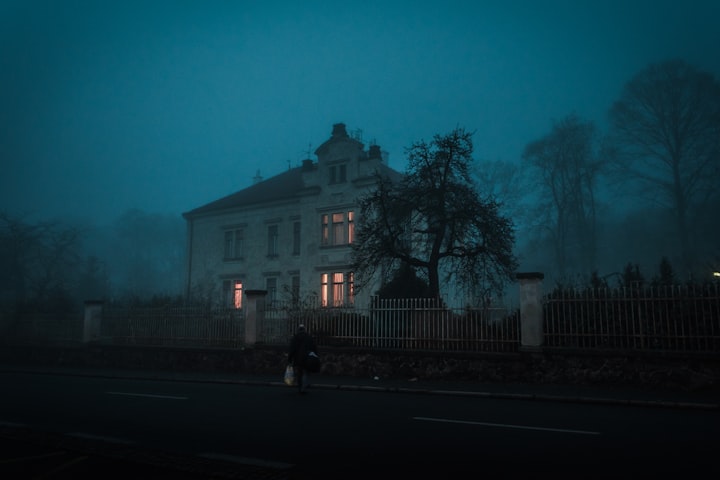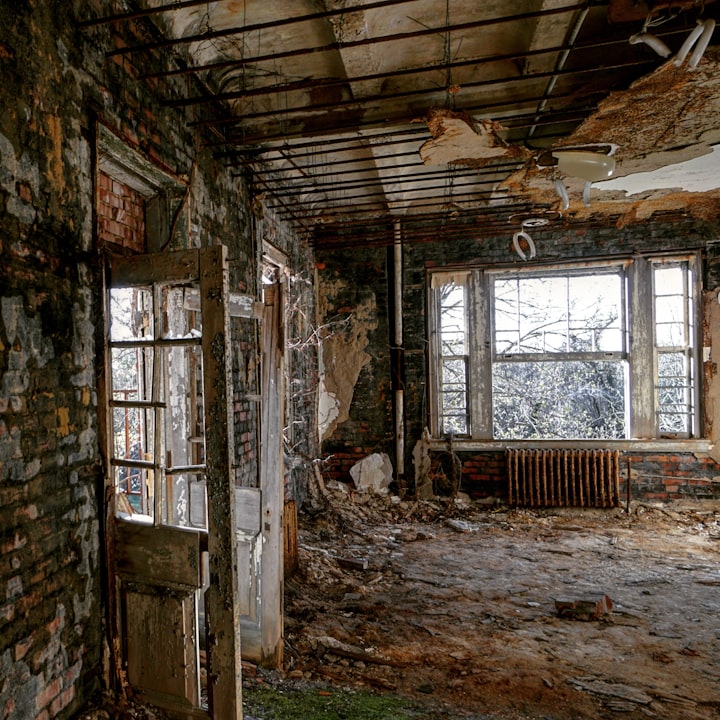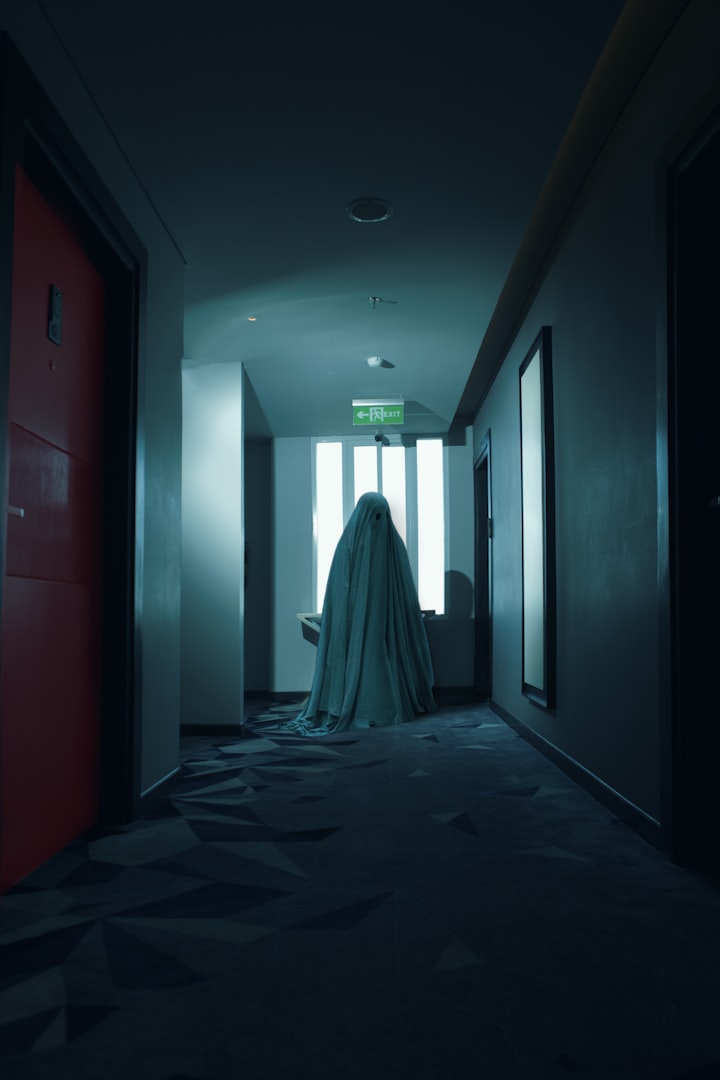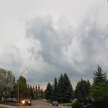The Battle of the Bad Old House: AFTERMATH (2021) vs THINGS HEARD & SEEN (2021)
A couple buys a house. The husband is eager, the wife is hesitant, and their differences only get worse after a series of unsettling encounters that force them to face the house's violent history.

Imagine this: a young couple buys a house only to uncover that these walls were witness to violence. Dangerous events escalate along with private frustrations. Evil has left a mark on this place, and that evil might be strong enough to split the marriage apart. The events boggle the imagination, but nothing stretches the audience's capacity for belief more than one detail:
You're telling me people can buy homes? Not just rent, but buy? And young people are doing this? But then... who is their landlord?!

It's Not Really Empty
The Haunted House remains one of our society's most persistent myths, despite demographic shifts towards renting and the millennial generation buying homes later and less frequently than the generations that preceded them. Among the variety of evil-place narratives released this year, Aftermath and Things Heard & Seen both travel familiar, murky ground:
A young, heterosexual couple at a liminal stage in their relationship decides to advance their relationship by buying a house. The husband is eager, the wife is hesitant, and their differences only get worse after a series of unsettling encounters that force them to face the house's violent history.

Of course there are differences: in Aftermath, all textual hints indicate that the movie is set in the modern day, while Things Heard & Seen takes place explicitly in the 1980s (cell-phones would complicate the plot). The husband in Aftermath is studying at a post-secondary institution, while the husband in Things Heard & Seen is teaching at a post-secondary institution. The family Aftermath has a dog, and the family in Things Heard & Seen has a child (who has about as much narrative impact as that dog).
Obviously, I'm cherry-picking here, but when I settled in to watch Things Heard & Seen, I couldn't help but make the comparison to Aftermath, a movie which I'd largely put out of my mind after first viewing. Now, looking at them side-by-side, I can't help but wonder what do their similarities and differences mean? How are we telling stories about hauntings in the current moment, and will these tropes remain part of our cultural dialogue even as the world changes?
Previously, I examined Escape Room (2017) and Escape Room (2019) to reveal what can be inferred from a comparison. Now we're doing it again, but this time with the myth of the Haunted House in 2021. So let's start with...
Aftermath (2021)

What exactly is the titular "aftermath"?
It could be that the Dadich's are about to move into a house where a murder took place. Or it could be that their relationship is on shaky footing after Natalie Dadich (Ashley Greene) had an affair. Or it could be the lingering trauma after Kevin Dadich (Shawn Ashmore) lost a brother.
Suffice it to say, the Dadich's lives would be complicated even if they lived in a house where things didn't go bump in the night.
However, while Aftermath definitely belongs to the greater genre of haunted house movies, it also belongs very specifically in the current moment. The house is surprisingly young for a movie of this genre--it's only had one owner before, although yes, that owner met a violent end. The house is not an old Victorian manor; it is remarkably modern. There's an emphasis placed on security cameras and alarm systems. Of course, those are ultimately useless when the haunting begins, but they exist as nods to modernity.
The same could not be said for...
Things Heard & Seen (2021)

Of the two movies, Things Heard & Seen aspires to greater artistic significance, which is obviously telegraphed even by the cast. The inclusion of Academy Award-winning actor F. Murray Abraham brings weight, and the movie is far more willing to introduce real-life matters like eating-disorders and homophobia.
However, it's also less bold than Aftermath when we are specifically discussing it as a haunted house. This move takes place in the 1980s, and the house has been around for even longer than that. If you had told me that the movie had been produced ten years ago, nothing about that would have surprised me.
To put it unkindly: Things Heard & Seen retreads the same sort of territory as better films like Crimson Peak and it never seems to achieve that level of tension or thrills. In fact, the movie often feels like it does not know what to do with its various parts. The movie introduces a character with an eating disorder, but then it only uses that as a blunt way to discredit her when she stars seeing ghosts. The movie introduces a set of homophobes, then does nothing to develop those ideas.
One wonders why, especially when the movie is ultimately just going to tumble down the same sort of haunted house tropes that we've come to expect from the genre.
Walls Soaked With Blood
Any time a horror movie introduces an evil place like this, it is dealing with the idea that places can hold echoes of trauma. The best of these movies pair that trauma with some trauma contained within the characters themselves. The story's development merges these two parallel lines, until the characters face their history in a place that has become--to some degree--the manifestation of their history. We recognise that there are echoes passing through time, and that the previous scenes in the house are in some way connected to the current scenes in the house.

As alluded to in my piece on the Escape Room movies, these generic expectations exist for a reason, and understanding their function is integral to understanding why a story works or fails to work.
Why set this movie in a haunted house? Why explore these relationships here and not on vacation or at a wedding? Why is this a movie with things that go bump in the night and not a movie where a young couple spends a weekend with the in-laws?
These choices are intentional, so why are they being made? And are they being made well?
Warnings
To really get into this, I need to make two things clear: while I will avoid discussing specifics of how these movies end, at this point we're going to venture into realms that could be seen as spoilers. If you're hyped for haunted houses, this is your chance to go watch these movies and then come back.
My second warning: I didn't love either of these movies, so if you feel hyped for haunted houses but you are underwhelmed by these movies, don't blame me. I think these movies are interesting. I wouldn't necessarily endorse watching them, unless they sound like exactly the sort of thing you love, and you need to kill 2 hours, and you're tired of watching The Woman in Black. If you want to save some time and skip watching them, you have my blessing.

Ready?
A Thought Experiment
Returning to the question about why these movies are set in haunted houses at all, let's run an experiment in our minds. If you haven't seen the movies, you'll just have to trust me, but if you have endured both of these films, here's the question: if you remove the haunting from either of these movies, how much changes?

We'll come back to this, but think it over.
The Power of Symbols
See, the reason why we continue to tell haunted house stories despite demographic changes is actually extremely interesting: the ownership of a home embodies a certain form of long-term commitment, rather like a marriage. If either of these movies were about haunted rentals, we could expect these young couples to just move on, but they have made a commitment to these houses just like they've made a commitment to each other.
This is the secret sauce that gives the haunted house it's enduring place in our landscape: houses feel permanent.
It's no coincidence, then, that both movies depict attempts at physical intimacy shortly after the couples enter into their homes. Like buying a house, the marriage-bed symbolically represents the attempt at commitment in the way that a one-night stand obviously does not. And when both couples are interrupted in their copulation, we understand on a symbolic level that their relationships are not functioning in ideal ways. Is this demonstrating assumptions about how our society views the primacy of sex in relationships? Yes. Are either movie going to try to deconstruct those assumptions in any way? No.

These are movies that are largely functioning on a symbolic level (house, sex, haunting, and so on--they're all potent symbols as much as they are diegetic elements of the narrative), which circles us back to the question we asked before: why have these movies chosen to use these symbols and not other symbols? What changes if we take the symbols away?
Returning to our thought experiment, if you remove the haunting from Aftermath, there is no movie. Nothing happens. The couple is mildly frustrated with each other, and possibly they divorce down the line, but the conflict is all focused through the lens of the haunting. This is a movie that needs a haunting. If you remove the haunting from Things Heard & Seen, the movie will largely unfold exactly as it did, just with a slightly different second act. That sounds like a bizarre assertion to make about the movie, but if you trace your way back through all of the characters' decisions and fates, it's very difficult to point to anything that is more than coincidentally connected to ghosts.
So What?
The end result are two movies that fail in different (but revealing) ways. By attempting to bring the haunted house into the modern era while adding very little to the formula except set-dressing, Aftermath feels insubstantial. It's the sort of horror movie you watch on Netflix and then forget until Netflix guesses that, despite all odds, you probably want to watch it again, and then the algorithm never lets you forget about it.
Aftermath has a moderate cast, and it feels like it was shot on a fairly limited budget. Could it have been great? If they found something new or exciting, sure, but they didn't. The movie hauls the haunted house into the modern era, only to just play through the exact same steps as before. Even the scene where the couple purchases the house feels awkward and stilted, because it feels like a sequence from a bygone era that's just been recreated with modern images. When the final twist unfolds, trying to differentiate it from other ghost movies, you'll probably just think, Huh. Weird. And rather than feeling fresh, you might find your mind turning to a certain cartoon with a cowardly, ghost-hunting dog.
Things Heard & Seen, however, has no excuse for it's quality, and it's not just forgettable: it's bad. It feels incompetent. Characters disappear for huge chunks of the movie, only to change the outcome of the story via coincidence. The plot never hinges on the inclusions of ghosts, but the exact ownership of a scarf will radically alter the plot. While I haven't been able to find the budget, this feels like a far more expensive movie. Natalia Dyer and F. Murray Abraham both play minor rolls, and neither are given much to do with their respective capacity as performers.
Are there better moments in Things Heard & Seen than in Aftermath? Definitely. Towards the back half of the movie, tension actually begins to build as secrets come forward, reshaping the audience's perspective on the various characters. Only even that reshaping feels lazy. A bad character is worse than you thought. A self-sacrificing character is more self-sacrificing than you thought. Again, the twists become interesting, but they never really click into place in a way that meshes with the world of symbols that the movie has already invoked.
While Aftermath feels like a disposable bit of fluff, Things Heard & Seen feels like an expensive, well-oiled machine where the gears never quite meet. Aftermath is unimaginative, while Things Heard & Seen invokes tropes without any real understanding of how to pay those off.
If you are interested in a haunted house movie that actually manages to succeed at playing with these ideas in the modern era, check out my review of "No One Gets Out Alive." Is it a great movie? I'll leave that for you to decide. But I will confidently say that it is more interesting than either of these. Also, check out the third and final entry in my comparison series where I examine the implications of horror movie remakes.
About the Creator
Littlewit Philips
Short stories, movie reviews, and media essays.
Terribly fond of things that go bump in the night.






Comments
There are no comments for this story
Be the first to respond and start the conversation.